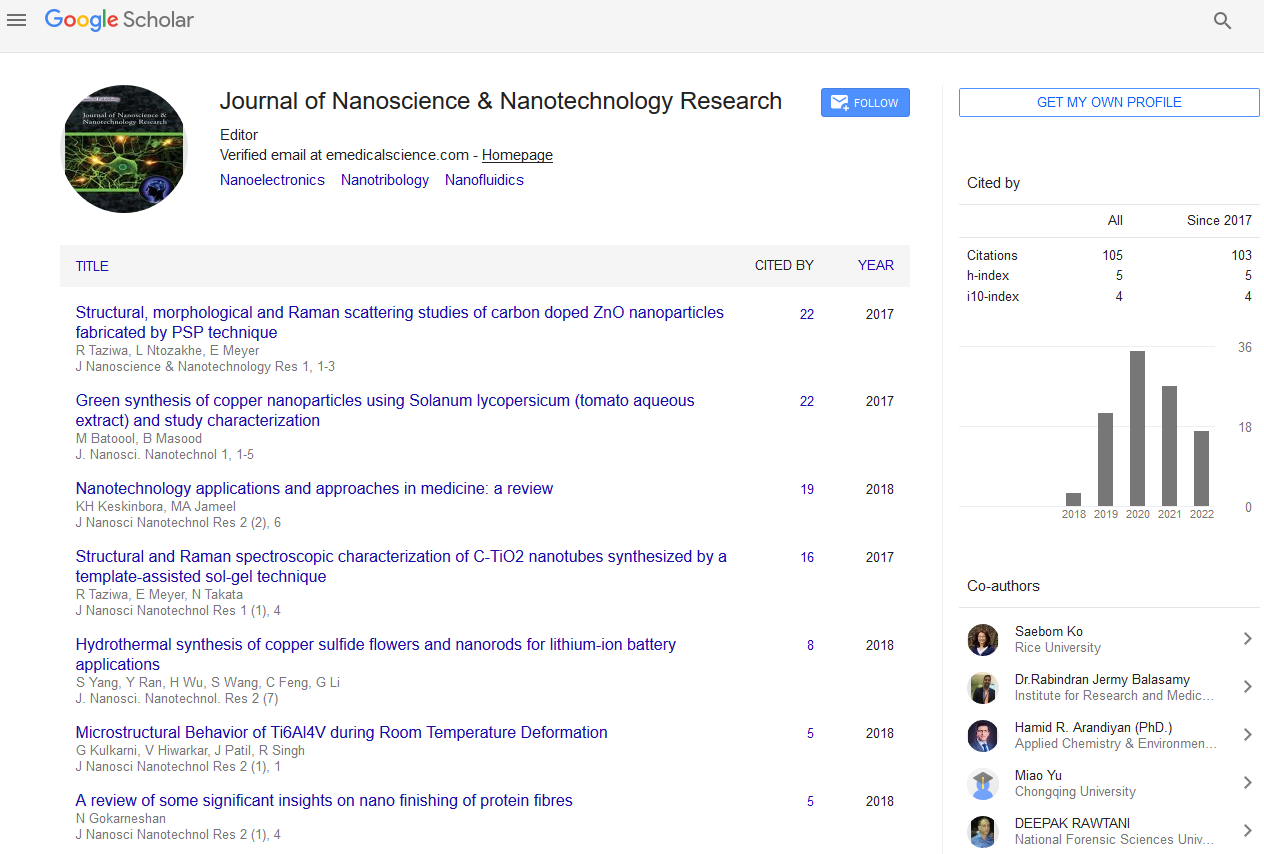Commentary - (2024) Volume 8, Issue 4
Nanofluidics: The Science of Fluids at the Nanoscale
Elisa Ricci*
Department of Bio-Nanotechnology, University of Bologna, Italy
*Correspondence:
Elisa Ricci,
Department of Bio-Nanotechnology, University of Bologna,
Italy,
Email:
Received: 02-Dec-2024, Manuscript No. IPNNR-25-22461;
Editor assigned: 04-Dec-2024, Pre QC No. IPNNR-25-22461 (PQ);
Reviewed: 18-Dec-2024, QC No. IPNNR-25-22461;
Revised: 23-Dec-2024, Manuscript No. IPNNR-25-22461 (R);
Published:
30-Dec-2024, DOI: 10.12769/IPNNR.24.8.33
Description
Nanofluidics is a rapidly evolving field that explores the behavior,
manipulation, and applications of fluids confined to nanometerscale
dimensions. This interdisciplinary science integrates
principles from physics, chemistry, biology, and engineering
to develop novel technologies with applications in healthcare,
energy, and materials science. As the world moves toward
miniaturization, nanofluidics plays a pivotal role in advancing
lab-on-a-chip devices, molecular diagnostics, and targeted
drug delivery systems. At the nanoscale (typically 1-100 nm),
fluid behavior deviates significantly from macroscopic fluid
mechanics due to dominant surface interactions, quantum
effects, and molecular confinement. Classical fluid dynamics
governed by the Navier-Stokes equation becomes inadequate,
and alternative theoretical models incorporating slip flow,
electrokinetics, and molecular dynamics simulations become
essential. Key characteristics of nanofluidic systems include.
Due to the high surface-area-to-volume ratio, interfacial forces
such as van der Waals interactions, electrostatic forces, and
hydrophobic effects dominate fluid behavior. Nanofluidic
systems enable precise control of biomolecules, allowing for
rapid diagnostics and biomarker detection at ultra-low sample
volumes. Lab-on-a-chip devices leverage nanofluidics to
perform functions such as DNA sequencing, protein analysis,
and point-of-care testing. For instance, nanopore-based
sequencing techniques have revolutionized genomic research
by enabling single-molecule detection and real-time analysis.
Nanofluidics is instrumental in developing controlled drug
release mechanisms, where nanoscale channels regulate the
transport of therapeutic agents. These systems enhance drug
efficacy, reduce side effects, and improve patient outcomes.
Liposomal and polymeric nanocarriers utilize nanofluidic
principles to optimize drug encapsulation and targeted delivery
to diseased tissues. These membranes offer precise molecular
separation capabilities, removing contaminants and salt ions
while maintaining high flow rates. Despite its vast potential,
nanofluidics faces several challenges, including fabrication
complexities, precise control of nanoscale transport,
and integration with existing technologies. Advanced
manufacturing techniques, such as 3D nanoprinting and selfassembly
methods, are being explored to overcome these
limitations. Nanofluidics represents a transformative domain
in science and engineering, offering unparalleled opportunities
for innovation in diverse fields. By unraveling the complexities
of fluid dynamics at the nanoscale, researchers continue to
push the boundaries of healthcare, energy, and environmental
technologies. As advancements in nanofabrication and
computational modeling continue, nanofluidics is poised to
shape the future of nanotechnology and molecular engineering,
revolutionizing industries and improving lives worldwide.
Looking ahead, nanofluidics is expected to drive breakthroughs
in personalized medicine, micro/nanorobotics, and artificial
biological systems. Emerging areas such as DNA nanotechnology
and hybrid bio-nano interfaces promise to further enhance our
ability to manipulate fluids at the molecular level, leading to
unprecedented scientific and technological advancements.
Acknowledgement
None.
Conflict Of Interest
None.
Citation: Ricci E (2024) Nanofluidics: The Science of Fluids at the Nanoscale. J Nanosci Nanotechnol Res. 8:33.
Copyright: © 2024 Ricci E. This is an open-access article distributed under the terms of the Creative Commons Attribution License, which permits unrestricted use, distribution, and reproduction in any medium, provided the original author and source are credited.

